Wednesday, 8 June 2011: Mâcon to Igé (and Cluny)
Written 16 June 2011
By Wednesday morning, time to check out, nothing more had been said about the garage door or the broken stone. One other hotel person had made his appearance, but he was unfailingly cheerful and smiling when we crossed paths, so I didn't know whether he was the "Monsieur" who had to be consulted about the mishap or not, so I hesitated to bring it up. But when we arrived at reception Wednesday morning, his manner was grave—clearly, he had at last been told. We checked out normally, but as he handed us the receipt he said, "And now, about the door . . . ." I apologized for breaking the stone, a sarcophagus cover, but we agreed that nothing could be done about that. We offered to pay for repairs to the door, but he didn't know what it would cost, whether it would have to be repaired or replaced, etc. In the end, he was very gracious about it. He would take care of the door, we would cover the damage to the car, and he hoped we would retain a pleasant memory of his establishment.
Our Michelin map of the region is not quite detailed enough—the smallest roads don't show route numbers, and the smallest villages aren't marked at all—so finding tiny Igé had us a little worried, but in the end we had no problem, and my Google area map got to to the château-hotel itself. Actually, because Igé is so small, Google places everything in it at the center of town, where the church is, but comparing photos of the establishment from its website with Google's aerial view of the village made clear that the big structure with the two round towers was actually a couple of blocks away, on rue du Château.
We pulled in long enough to drop off our luggage (it was still midmorning), then headed off over the mountain to Cluny. Again, the road was very tiny (and the pavement was beaten to rubble for a couple of kilometers on either side of an industrial stone quarry that lay along the way), but we took careful note of each turn, in case the way back to Igê wasn't as clearly signposted as that to the much larger Cluny, but we needn't have worried—easy to follow in both directions. It is also steep! We passed road signs warning of 12% grades; I don't think that's even legal in the U.S.!
Cluny is famous, of course, as the home of the incredibly influential Abbaye de Cluny, the premier religious institution of the Middle Ages, but on this day we were there to see something else. As we left Cluny, on the rainy day in 2009 when we first toured it, we walked past the Haras National, the Cluny branch of the French National Equestrian Stud, and that was the third occasion on which we'd discovered the existence of such a branch without having time to tour it, so this time, we planned ahead.
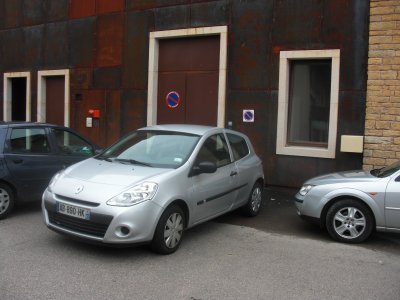
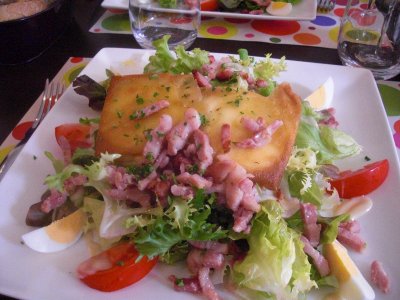 First on the agenda was lunch. We parked in one of Cluny's many peripheral free parking lots—the place is clearly set up to handle droves of tourists, but it was early in the year for the masses to have arrived—and walked into town. While detouring around the massive buildings of the National College of Arts and Occupations, not twenty yards from abundant free parking, I spotted this group of three cars parked at interesting angles, blocking a doorway and part of the road, directly below two prominent "no parking" signs—ah, France.
First on the agenda was lunch. We parked in one of Cluny's many peripheral free parking lots—the place is clearly set up to handle droves of tourists, but it was early in the year for the masses to have arrived—and walked into town. While detouring around the massive buildings of the National College of Arts and Occupations, not twenty yards from abundant free parking, I spotted this group of three cars parked at interesting angles, blocking a doorway and part of the road, directly below two prominent "no parking" signs—ah, France.
Once on the main street, we immediately came upon Le Comptoir, on rue Filaterie, where we had Salade Filaterie—goat cheese wrapped in feuilles de brik, fried hot and crispy, placed atop a pile of salad, and showered with lardons and hard-cooked eggs. Delicious.
Next, we presented ourselves at the gates of the Haras (a word meaning equestrian stud derived from the same Arabic word that gave rise to the English "harem") National for the 2 p.m. tour. We were the only ones to show up, so we had a private tour. The national stud, in the form of about 50 branches, was founded by Louis XIV, who got sick of having to buy cavalry horses from the British—he wanted to breed and raise his own. Good idea, economically sound, but of course the revolution came along and most of its branches were closed down. Napoleon, next up, also wanted a lot of cavalry horses, so he reinstituted the idea and built a bunch of new branches, including the one in Cluny (1810, I think). Today, demand for cavalry mounts has flagged, but about 20 branches of the stud remain, charged with maintaining heritage breeds of horses, keeping records of registered horses, etc. The Cluny branch specializes in draft horses—not necessarily the gigantic breeds that haul beer wagons and load logging wagons, but horses bred for work, particularly pulling carriages and wagons.
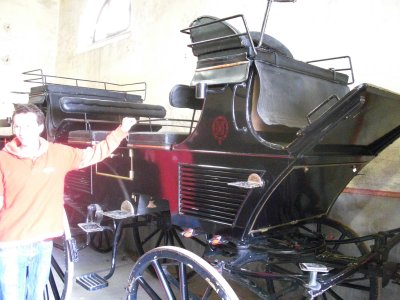
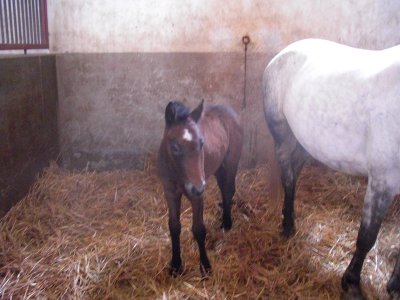 The tour started with the carriage barn, where a number of different styles of carriage and wagon are maintained for shows and training. At the left is a hunting brake. Note the louvered panels below the seats, fore and aft. Those are ventilated compartments for hunting dogs. Adjacent to it is the tackroom where the ceremonial and show harnesses are kept, including a sidesaddle (interesting to view up close). Next was the barn housing visiting brood mares. At the right is a two-week-old foal, too timid to come any closer. Mares are most fertile and most receptive to mating just after a foal is born, so mares to be bred are transported to the stud just before or just after they give birth. Most of the mares in the barn were therefore accompanied by their foals from previous matings.
The tour started with the carriage barn, where a number of different styles of carriage and wagon are maintained for shows and training. At the left is a hunting brake. Note the louvered panels below the seats, fore and aft. Those are ventilated compartments for hunting dogs. Adjacent to it is the tackroom where the ceremonial and show harnesses are kept, including a sidesaddle (interesting to view up close). Next was the barn housing visiting brood mares. At the right is a two-week-old foal, too timid to come any closer. Mares are most fertile and most receptive to mating just after a foal is born, so mares to be bred are transported to the stud just before or just after they give birth. Most of the mares in the barn were therefore accompanied by their foals from previous matings.
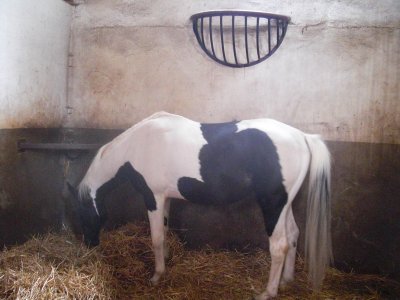
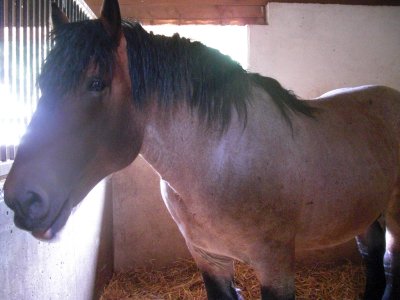 After that, we visited the barn where the stallions are kept. Apparently it stays pretty peaceful as long as the mares are elsewhere, but if a mare comes into the barn, all the stallions want to fight each other. At the left is Polar Kristall, acquired for his interesting markings. At the right, if I got my notes right, is an Auxois, one of two breeds currently being blended because each is now so rare that inbreeding would otherwise be a problem. Maybe the other of the two is the Comtois, but I'm not sure of that.
After that, we visited the barn where the stallions are kept. Apparently it stays pretty peaceful as long as the mares are elsewhere, but if a mare comes into the barn, all the stallions want to fight each other. At the left is Polar Kristall, acquired for his interesting markings. At the right, if I got my notes right, is an Auxois, one of two breeds currently being blended because each is now so rare that inbreeding would otherwise be a problem. Maybe the other of the two is the Comtois, but I'm not sure of that.
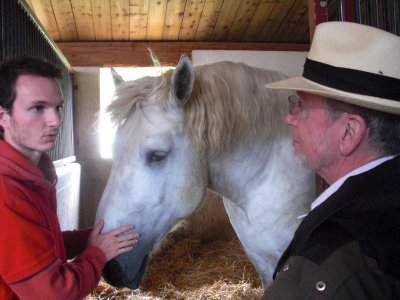
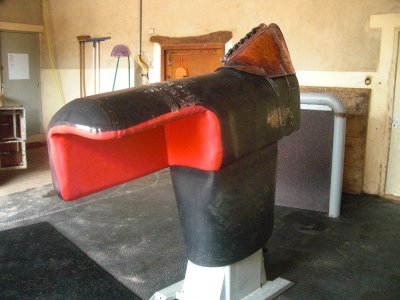 Here our guide pets a favorite of his (a Percheron, I think), and at the right is an astonishing object used in preparation for artificial insemination. Earlier, we had passed special narrow stalls in which mares were made to stand for their part in the process. This is where the stallions do their part. A live mare is placed between the short piece of stout railing and the far wall to excite the stallion, who is then encouraged to mount this "vaulting horse"; a technician stands by, on this near, open side, with collection apparatus. Each episode can produce the wherewithall for many inseminations, so individual doses are frozen for future use.
Here our guide pets a favorite of his (a Percheron, I think), and at the right is an astonishing object used in preparation for artificial insemination. Earlier, we had passed special narrow stalls in which mares were made to stand for their part in the process. This is where the stallions do their part. A live mare is placed between the short piece of stout railing and the far wall to excite the stallion, who is then encouraged to mount this "vaulting horse"; a technician stands by, on this near, open side, with collection apparatus. Each episode can produce the wherewithall for many inseminations, so individual doses are frozen for future use.
In cases where artificial insemination is not suitable (for example, in some countries, race horses must be bred "naturally" to be eligible for competition), a stallion named Tony comes into play. Tony is a technically a pony, but he's as large as some of the other stallions. He sole job is to assess the receptivity of mares. An unreceptive mare will resist the advances of an inportunate stallion, so rather than risk the well-being of the stud's more valuable stallions, the breeders introduce Tony to the mare. If she fetches him a swift kick in the ribs, they conclude she's not ready. On the other hand, if she seems pleased and stands ready, poor Tony is taken back to the barn and the "real" stallion is brought on the scene. Either way, natural or artificial, after a couple of weeks, pregnancy is confirmed (or not) by ultrasound, and if she's expecting, the mare is free to go home or wherever else she will spend her 11-month pregnancy.
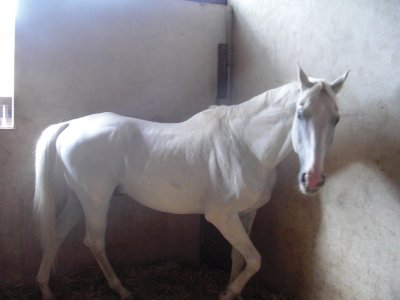
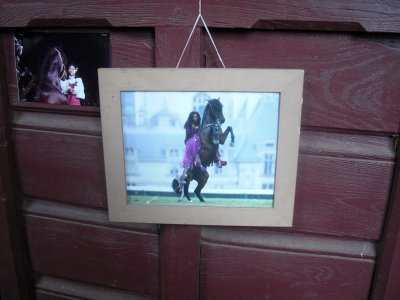 The last breeding stallion we met was this one, Quercus de Maury, an Anglo-Arabian born in 1992 (the oldest stallion at this stud). He's high-strung and was in constant motion; he never stopped walking around his box. At the right is a photo of a photo of the stud's current equestrian in residence, Sabrina Sow, who does all sorts of trick riding (including elaborately costumed stuff like this photo as well as circust-style trick riding and "liberty" work, in which the horse goes through dressage moves at her command without wearing any tack or her touching him). We met her at the beginning of the tour and hoped to get to watch her rehearse—we did get to meet five of her horses—but she was concerned about one of the horses' feet and put off the rehearsal.
The last breeding stallion we met was this one, Quercus de Maury, an Anglo-Arabian born in 1992 (the oldest stallion at this stud). He's high-strung and was in constant motion; he never stopped walking around his box. At the right is a photo of a photo of the stud's current equestrian in residence, Sabrina Sow, who does all sorts of trick riding (including elaborately costumed stuff like this photo as well as circust-style trick riding and "liberty" work, in which the horse goes through dressage moves at her command without wearing any tack or her touching him). We met her at the beginning of the tour and hoped to get to watch her rehearse—we did get to meet five of her horses—but she was concerned about one of the horses' feet and put off the rehearsal.
As you could see from the photos, all the horses live in loose boxes, although the stud has retained one disused row of the old-fashioned stalls, too narrow for the horses to turn around in, as a museum piece. Each horse is taken out for exercise, although not necessarily for work, every day—either ridden or harnessed for work, turned into a field for "recess," or walked in a circular walking arena where a machine leads them continually in a circle (like the pony rides at the fair, but bigger). The grounds are beautifully kept and feature a 200-year old plane tree planted when the haras was founded. They also include exercise and show rings. About 30 people work there in all, but that includes administration and grounds keepers, in addition to the people who have anything to do with the horses.
Unfortunately, like the very upscale Hotel de Bourgogne, the haras built partly on the site of the Abbaye de Cluny. The people restoring the abbey would like to tear some of it down, but the haras is also a national monument, and so far, the abbey's senior standing as a national monument has not prevailed.
After our tour, we strolled around the town a little more before heading back to the car and back over the mountain to the hotel. The drive is amazingly scenic, through thick forest with higher diversity than you usually see in France (oaks, sycamore maples, birches, conifers (firs?), hornbeams, wild cherries, box-elders, ashes, birches, chestnuts (in bloom), locusts; blackberries, foxgloves, elderberry, and bracken in the sunny spots; other ferns in the shady spots).
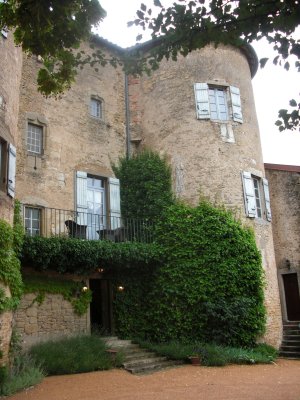
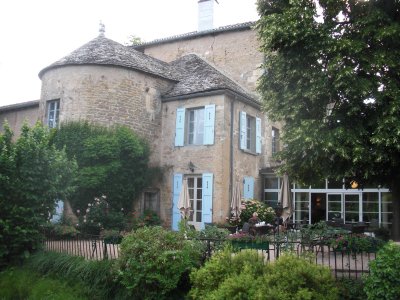 The Château d'Igé, both our hotel and our restaurant for two nights, is just lovely. At the left is the front entrance, which gives access to the restaurant, jardin d'hiver (the winter garden, a glassed-in area where breakfast was served), and some of the rooms. Our room was reached through a separate door just out of the photo to the left.
The Château d'Igé, both our hotel and our restaurant for two nights, is just lovely. At the left is the front entrance, which gives access to the restaurant, jardin d'hiver (the winter garden, a glassed-in area where breakfast was served), and some of the rooms. Our room was reached through a separate door just out of the photo to the left.
At the right is the view from the side, showing, beyond the iron railing, the terrace (with tables, chairs, and silver-gray café umbrellas) and the glass doors of the jardin d'hiver.
Between the railing and the camera is the beautiful pool shown below at the right. A sort of stylized crocodile made of tiles shoots the fountain across the pool toward a stone footbridge.
At night, the arches under the foot bridge are lighted from below. Beautiful.
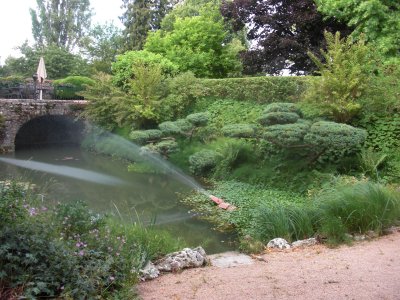
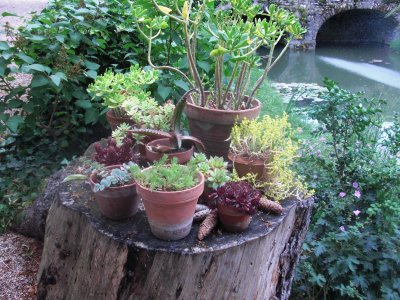 The garden is full of wonderful little touches like this cluster of potted sedums.
The garden is full of wonderful little touches like this cluster of potted sedums.
Dinner was at the hotel's restaurant. We sat on the terrace outside the summer garden while David had his customary apperitif of a coupe de champagne and we studied the menu. Once inside, we were ready to order. We chose the "gastronomy" menu, which offered a couple of choices for each course and incorporated most of the dishes we wanted to order.
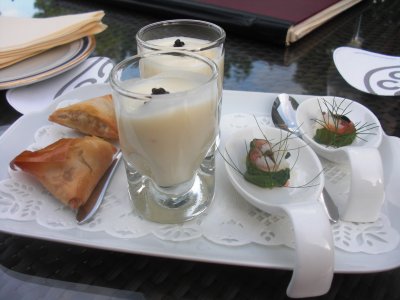
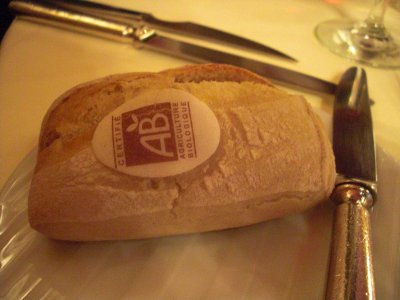 Amuse-bouche, both: crispy briks (filled with something; I forget what); glasses of cold "potage DuBarry" (cauliflower soup, delicious); tiny, rather disorganized sushi of salmon—not very Asian flavored, but delicious nonetheless.
Amuse-bouche, both: crispy briks (filled with something; I forget what); glasses of cold "potage DuBarry" (cauliflower soup, delicious); tiny, rather disorganized sushi of salmon—not very Asian flavored, but delicious nonetheless.
The bread was all baked in house, and this variety (one of several offered) came with a little edible rice-paper label baked right onto it, specifying that it was 100% the product of certified organic agriculture.
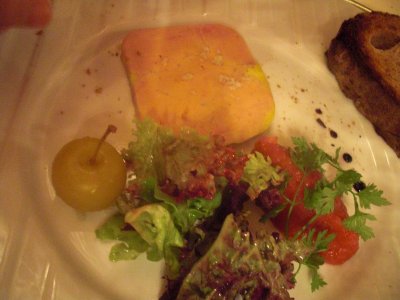
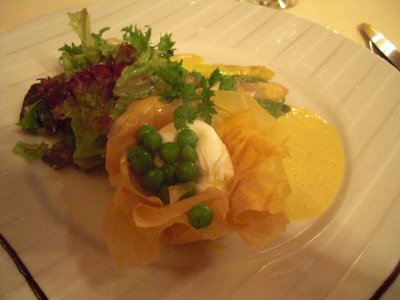 First course, David: A slice of terrine of foie gras with a quenelle of apple-black-currant compote and, according to the menu, "quelques pousses de Vigna del Oro"—some sprouts of golden vine. What actually appeared on the plate was a "pomme chinoise," a little braised crabapple.
First course, David: A slice of terrine of foie gras with a quenelle of apple-black-currant compote and, according to the menu, "quelques pousses de Vigna del Oro"—some sprouts of golden vine. What actually appeared on the plate was a "pomme chinoise," a little braised crabapple.
First course, me: A "fresh" poached egg (quotation marks theirs) in a crispy shell (made of feuilles de brik) with fresh green peas, a small salad, and both green and white asparagus with foamy chicken-and-chorizo sauce. Delicious.
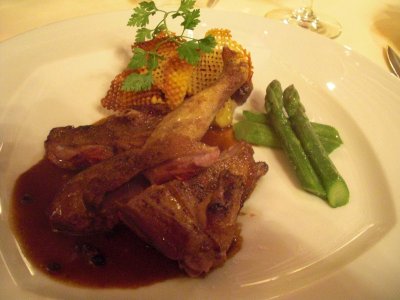
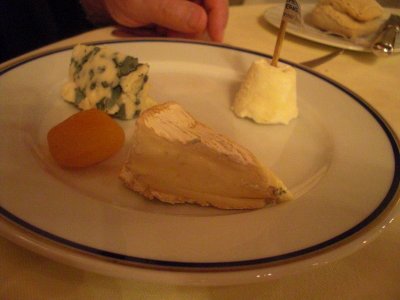 Main course, both: Whole rare roast pigeon (carved up for easier eating) with a rich reduction sauce, asparagus, and crispy waffle potato chips. Excellent.
Main course, both: Whole rare roast pigeon (carved up for easier eating) with a rich reduction sauce, asparagus, and crispy waffle potato chips. Excellent.
Cheese, David: Camembert, Roquefort, and a dryish fresh chèvre, with one dried apricot. He really liked the chèvre (which is shaped as a "baratte," a churn; hence the stick stuck in the top, to represent the dasher). Since then, he's been watching for similar chèvres on cheese trays.
Cheese, me: Valençay; a rather dry, sharp neuchatel; and a small dry chèvre—all rather similar in appearance and thus less photogenic (but delicious!). Also accompanied by an apricot.
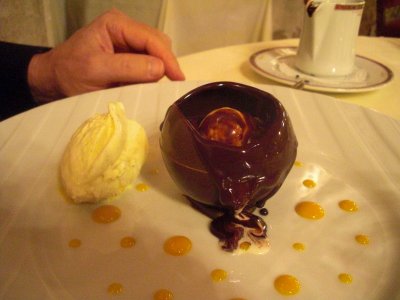
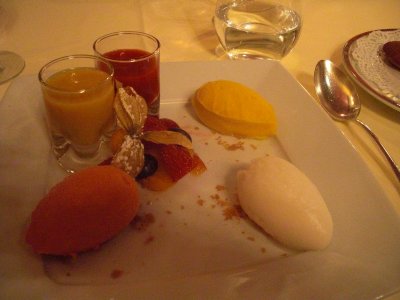 Dessert, David: A "chocosphere," same idea as the "cocque surprise," but this time containing vanilla ice cream and opened in the center rather than melted into two halves. You can see that the seam runs horizontally around this one, which we think would be easier. The original had the seam running vertically, and we're still not sure how he assembled it. David raved about it once more.
Dessert, David: A "chocosphere," same idea as the "cocque surprise," but this time containing vanilla ice cream and opened in the center rather than melted into two halves. You can see that the seam runs horizontally around this one, which we think would be easier. The original had the seam running vertically, and we're still not sure how he assembled it. David raved about it once more.
Dessert, me: A trio of house-made sorbets—mango, litchi, and strawberry—with two fruit sauces—red-fruit and passionfruit. On the side, three miniature lemon madeleines.
Mignardises: small, unfilled cream puffs dipped in caramel that hardened into a crispy shell; tuile cookies; and tiny tarts, each filled with one berry, a tiny slice of peach, and a tiny slice of kiwi.
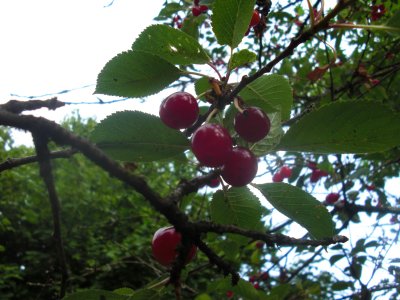 Finally, just another photo from the garden. The black cherry tree was almost finished fruiting, but the wild strawberries were just starting, and this sour-cherry tree was laden. I ate a few, and they were delicious—soft and amazingly juicy.
Finally, just another photo from the garden. The black cherry tree was almost finished fruiting, but the wild strawberries were just starting, and this sour-cherry tree was laden. I ate a few, and they were delicious—soft and amazingly juicy.
previous entry
List of Entries
next entry

 First on the agenda was lunch. We parked in one of Cluny's many peripheral free parking lots—the place is clearly set up to handle droves of tourists, but it was early in the year for the masses to have arrived—and walked into town. While detouring around the massive buildings of the National College of Arts and Occupations, not twenty yards from abundant free parking, I spotted this group of three cars parked at interesting angles, blocking a doorway and part of the road, directly below two prominent "no parking" signs—ah, France.
First on the agenda was lunch. We parked in one of Cluny's many peripheral free parking lots—the place is clearly set up to handle droves of tourists, but it was early in the year for the masses to have arrived—and walked into town. While detouring around the massive buildings of the National College of Arts and Occupations, not twenty yards from abundant free parking, I spotted this group of three cars parked at interesting angles, blocking a doorway and part of the road, directly below two prominent "no parking" signs—ah, France. 
 The tour started with the carriage barn, where a number of different styles of carriage and wagon are maintained for shows and training. At the left is a hunting brake. Note the louvered panels below the seats, fore and aft. Those are ventilated compartments for hunting dogs. Adjacent to it is the tackroom where the ceremonial and show harnesses are kept, including a sidesaddle (interesting to view up close). Next was the barn housing visiting brood mares. At the right is a two-week-old foal, too timid to come any closer. Mares are most fertile and most receptive to mating just after a foal is born, so mares to be bred are transported to the stud just before or just after they give birth. Most of the mares in the barn were therefore accompanied by their foals from previous matings.
The tour started with the carriage barn, where a number of different styles of carriage and wagon are maintained for shows and training. At the left is a hunting brake. Note the louvered panels below the seats, fore and aft. Those are ventilated compartments for hunting dogs. Adjacent to it is the tackroom where the ceremonial and show harnesses are kept, including a sidesaddle (interesting to view up close). Next was the barn housing visiting brood mares. At the right is a two-week-old foal, too timid to come any closer. Mares are most fertile and most receptive to mating just after a foal is born, so mares to be bred are transported to the stud just before or just after they give birth. Most of the mares in the barn were therefore accompanied by their foals from previous matings.
 After that, we visited the barn where the stallions are kept. Apparently it stays pretty peaceful as long as the mares are elsewhere, but if a mare comes into the barn, all the stallions want to fight each other. At the left is Polar Kristall, acquired for his interesting markings. At the right, if I got my notes right, is an Auxois, one of two breeds currently being blended because each is now so rare that inbreeding would otherwise be a problem. Maybe the other of the two is the Comtois, but I'm not sure of that.
After that, we visited the barn where the stallions are kept. Apparently it stays pretty peaceful as long as the mares are elsewhere, but if a mare comes into the barn, all the stallions want to fight each other. At the left is Polar Kristall, acquired for his interesting markings. At the right, if I got my notes right, is an Auxois, one of two breeds currently being blended because each is now so rare that inbreeding would otherwise be a problem. Maybe the other of the two is the Comtois, but I'm not sure of that.
 Here our guide pets a favorite of his (a Percheron, I think), and at the right is an astonishing object used in preparation for artificial insemination. Earlier, we had passed special narrow stalls in which mares were made to stand for their part in the process. This is where the stallions do their part. A live mare is placed between the short piece of stout railing and the far wall to excite the stallion, who is then encouraged to mount this "vaulting horse"; a technician stands by, on this near, open side, with collection apparatus. Each episode can produce the wherewithall for many inseminations, so individual doses are frozen for future use.
Here our guide pets a favorite of his (a Percheron, I think), and at the right is an astonishing object used in preparation for artificial insemination. Earlier, we had passed special narrow stalls in which mares were made to stand for their part in the process. This is where the stallions do their part. A live mare is placed between the short piece of stout railing and the far wall to excite the stallion, who is then encouraged to mount this "vaulting horse"; a technician stands by, on this near, open side, with collection apparatus. Each episode can produce the wherewithall for many inseminations, so individual doses are frozen for future use.
 The last breeding stallion we met was this one, Quercus de Maury, an Anglo-Arabian born in 1992 (the oldest stallion at this stud). He's high-strung and was in constant motion; he never stopped walking around his box. At the right is a photo of a photo of the stud's current equestrian in residence, Sabrina Sow, who does all sorts of trick riding (including elaborately costumed stuff like this photo as well as circust-style trick riding and "liberty" work, in which the horse goes through dressage moves at her command without wearing any tack or her touching him). We met her at the beginning of the tour and hoped to get to watch her rehearse—we did get to meet five of her horses—but she was concerned about one of the horses' feet and put off the rehearsal.
The last breeding stallion we met was this one, Quercus de Maury, an Anglo-Arabian born in 1992 (the oldest stallion at this stud). He's high-strung and was in constant motion; he never stopped walking around his box. At the right is a photo of a photo of the stud's current equestrian in residence, Sabrina Sow, who does all sorts of trick riding (including elaborately costumed stuff like this photo as well as circust-style trick riding and "liberty" work, in which the horse goes through dressage moves at her command without wearing any tack or her touching him). We met her at the beginning of the tour and hoped to get to watch her rehearse—we did get to meet five of her horses—but she was concerned about one of the horses' feet and put off the rehearsal.
 The Château d'Igé, both our hotel and our restaurant for two nights, is just lovely. At the left is the front entrance, which gives access to the restaurant, jardin d'hiver (the winter garden, a glassed-in area where breakfast was served), and some of the rooms. Our room was reached through a separate door just out of the photo to the left.
The Château d'Igé, both our hotel and our restaurant for two nights, is just lovely. At the left is the front entrance, which gives access to the restaurant, jardin d'hiver (the winter garden, a glassed-in area where breakfast was served), and some of the rooms. Our room was reached through a separate door just out of the photo to the left.
 The garden is full of wonderful little touches like this cluster of potted sedums.
The garden is full of wonderful little touches like this cluster of potted sedums.
 Amuse-bouche, both: crispy briks (filled with something; I forget what); glasses of cold "potage DuBarry" (cauliflower soup, delicious); tiny, rather disorganized sushi of salmon—not very Asian flavored, but delicious nonetheless.
Amuse-bouche, both: crispy briks (filled with something; I forget what); glasses of cold "potage DuBarry" (cauliflower soup, delicious); tiny, rather disorganized sushi of salmon—not very Asian flavored, but delicious nonetheless.
 First course, David: A slice of terrine of foie gras with a quenelle of apple-black-currant compote and, according to the menu, "quelques pousses de Vigna del Oro"—some sprouts of golden vine. What actually appeared on the plate was a "pomme chinoise," a little braised crabapple.
First course, David: A slice of terrine of foie gras with a quenelle of apple-black-currant compote and, according to the menu, "quelques pousses de Vigna del Oro"—some sprouts of golden vine. What actually appeared on the plate was a "pomme chinoise," a little braised crabapple.
 Main course, both: Whole rare roast pigeon (carved up for easier eating) with a rich reduction sauce, asparagus, and crispy waffle potato chips. Excellent.
Main course, both: Whole rare roast pigeon (carved up for easier eating) with a rich reduction sauce, asparagus, and crispy waffle potato chips. Excellent.
 Dessert, David: A "chocosphere," same idea as the "cocque surprise," but this time containing vanilla ice cream and opened in the center rather than melted into two halves. You can see that the seam runs horizontally around this one, which we think would be easier. The original had the seam running vertically, and we're still not sure how he assembled it. David raved about it once more.
Dessert, David: A "chocosphere," same idea as the "cocque surprise," but this time containing vanilla ice cream and opened in the center rather than melted into two halves. You can see that the seam runs horizontally around this one, which we think would be easier. The original had the seam running vertically, and we're still not sure how he assembled it. David raved about it once more. Finally, just another photo from the garden. The black cherry tree was almost finished fruiting, but the wild strawberries were just starting, and this sour-cherry tree was laden. I ate a few, and they were delicious—soft and amazingly juicy.
Finally, just another photo from the garden. The black cherry tree was almost finished fruiting, but the wild strawberries were just starting, and this sour-cherry tree was laden. I ate a few, and they were delicious—soft and amazingly juicy.